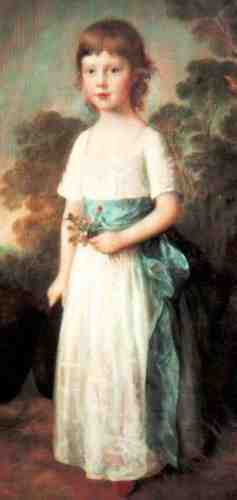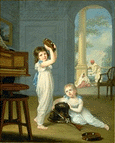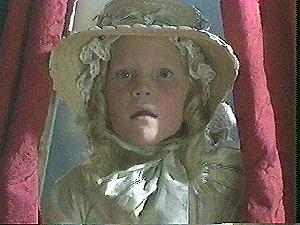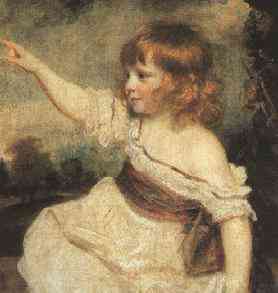'

Boys' Dresses: 18th Century
Background

Figure 1.--One of the great English portratists is Sir Thomas Gainsbourough. He painted this portrait of Master John Heathcote about 1771. Note the low neckline, blue sash, and the fact he is holding flowers. The boy looks to be about 8 years old. (Remember children before the 20th Century look younger than modern children.)
|
Europeans beginning in the 16th century dressed little children, both boys and girls in the same styles of ankle-length dresses, often referred to as petticoats. For most of this time, no special clothing existed for children, boys or girls. Boys once 'breeched', were simplly dressed in smaller versions of the knee breeches and other clothes worn by their fathers. Specialized clothing for children did not appear until the late 18th centuty-- and a first only for boys. Even so, many mothers continued to dress small boys in dresses for more than a century.
Chronology
I have little information on fashion changes for boys' dresses during the 18th century. I believe they were esentially just a reflectiion of fashion trands for womens' dresses during thevperiod. At the tail end of the 18th century and the very beginning of the 19th was a real state of flux for fashion; the "grecian" style was still very new, as was the idea of putting children in something more comfortable than an exact reproduction
of adult wear, and there were many variations.
Dress Styles in the 18th Century
Small boys throughout the 18th Century wore dresses. The fashions chnanged only as overall fashions for women's dresses changed. After mid-century girls and younger boys not yet began to be dressed in less restrictive, more comfortable white cotton or linen frocks. Commonly the dresses had drawstrings tieing at the back and low necklines. One popular feature was decorating the white frocks with wide, colorful waist sashes. Blue sashes were vey popular for both boys and girls.
Dresses for Boys
HBC still has relatively limited information on boy dress styles in the 1700s. They apparently were just small sized versions of their mothers' dresses. Both boys and girls wore the same-styled dresses. There were no dresses made especially for boys. No one at the time had even conceived of such a thing. It is clear that the fashion of dressing small boys in dresses was the prevalent fashion throughout the 18th century.
Sleeves
Hem lines
Neckline
One stylistic feature sometimes used to identify the gender of children wearing dresses in old paintings and photographs is the neckline as low necklines look feminine to modern viewers. It is clear, however, from many 18th Century paintings that the neckline simply followed contemportary fashions trends and had nothing to do with gender.
Dresses for children in the 18th Century continued to have "leadimg strings," a feature which became popular in the 16th Century. Leading stings were precisely what they sounded like. They strips of fabric matching or coordinated with the dress fabric that were sewn on to the dress at the shoulders. The other end fell freely down the back of the dress. Some dresses did not have leading strings sewb on directly, but they would be pinned on if the mother so desired. The "strings" were considered practical for rambuncious young children and were used rather as a lease. Practices and conventions varied for boys and girls.
Materials

Figure 2.--Little boys throughout the 18th century wore dresses like their sisters.
|
|
Developing Children's Fashions
The fashion of dressing small boys in dresses continued in the 18th century, although there were significant changes in fashions for children toward the end of the century when
specialized fashions for children--especially boys began to appear. I have relatively little information, but am pursuing the topic. Little boys for most of the 18th century still wore dresses like their sisters smocks until they were "breeched"--allowed to wear mens' knee breeches. The age at which this occurred varried greatly from family to family and was up to the disgression of the mother. I believe this was a widespread practice throughout Europe, but have little information on many countries.

Figure 3.--The dresses worn by little boys were shown in great detail in the elaborately costumed movie, "The Madness of King George".
|
Relatively little written material exists on the styles of the dresses worn by children. I think that this was primarily because there were no specific styles for children's dresses. Much of what we know has been deduced from contemporary portraits and other paintings. It is amazing to some modern observers to find when studying the contemporary portraits of children that one often cannot tell boy from girl except by name. This is because there was little differentiation in the styles of the dresses worn by girls and boys rather there seem to have been generic styles for chuldren.
Attitude of the Boys
We know relatively little about what the boys of the era thought about wearing dresses. As destinctive styles for children did not exist for much of the period and the children involved were very young, it is likely that the fashion was of less concern to the boys than was the case for more modern generations. In addition, children of the era generally defered to their parents on such matters.

Figure 4.--The dresses worn by little boys in the 18th Century were indistinguisable from those worn by girls. This 1788 Reynolds painting is of Master Hare.
|
There must have been some family letters in which this is mentioned or adult memoirs of the boys so attired. At least some boys seemed to have worn dresses well beyond the toddler age. The Gainsborough painting of Master John Heathcote, for example, looks to be about 8 years old, perhaps older. Boys of this age presumably carried their childhood memories into adulthood. Hopefully HBC readers will know of pertinent reading material and share it with us.
Breeching
I have not yet found any written material describing breeching in the 18th Century. Thus I do not know at what age this took place, differences between nationalities or social classes, and other interesting information.
Childrens Clothes
Specialized clothes for children first appeared during the latter 18th Century. Previously boys had just worn scaled down versions of their father's clothes. This novel concept did not become fully accepted until the 19th Century. Boys began wearing skeleton suits and by the 1790s long trousers, while their fathers still wore knee breeches. I'm not sure if this affected the styles of dresses with special children's styles.
Christopher Wagner

Navigate the Historic Boys' Clothing Web chronological pages:
[The 1500s][The 1600s]
[The 1700s]
[The 1770s]
[The 1800s]
[The 1810s]
[The 1820s]
[The 1830s]
[The 1840s]
[The 1850s]
Navigate the Historic Boys' Clothing Web dress pages:
[Return to themain dress page]
[Pinafores]
[Ringlet curls]
[Smocks]
[Bodice kilts]
[Kilts]
[Fauntleroy dresses]
[Sailor dresses]
[Fancy dresses]
[Dresses: 17th Century]
[Dresses: 18th Centuries]
[Dresses: Early-Mid-19th Century]
[Dresses: Late-19th Century]
[Dresses: Early 20th Century]
[Difficult images]
[Movie dresses]
Navigate the Boys' Historical Clothing Web Site:
[Introduction]
[Activities]
[Biographies]
[Chronology]
[Clothing styles]
[Countries]
[Bibliographies]
[Contributions]
[FAQs]
[Glossaries]
[Images]
[Links]
[Registration]
[Boys' Clothing Home]
Created: October 13, 1998
Updated: 5:38 AM 7/28/2010






